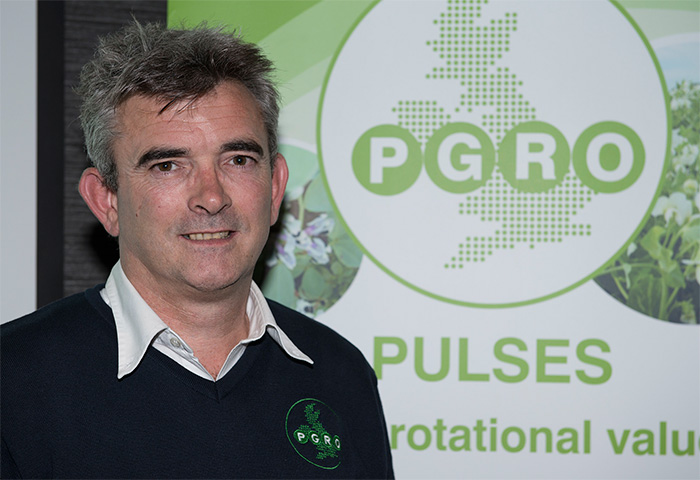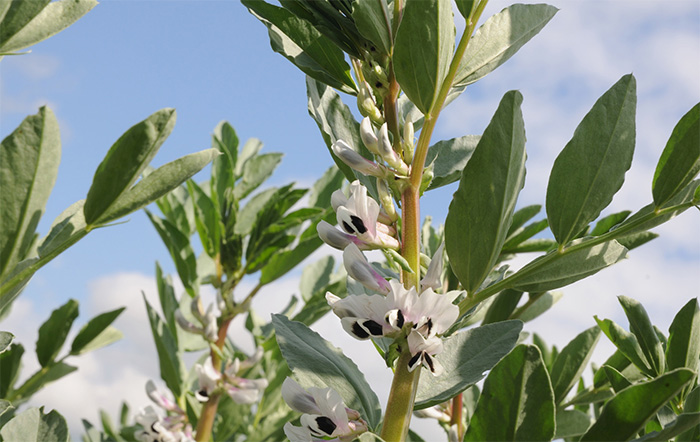
A series of free Pulse Roadshows have given arable farmers and agronomists an essential update on options for profitable pea and bean cropping this season. Presented across the country by PGRO and Syngenta, the meetings have explored all aspects of the crops’ agronomy and marketing.
The extremely popular meetings also gave the chance to quiz specialists from PGRO and Syngenta about the latest developments, and learn from the experiences of other growers.
Breeding better beans
Pulse crop plant breeders lost 15 years of advances and capabilities through the switch from public to private ownership in the UK - with the number of breeding companies across the EU falling from more than 30, to less than 10 over the past decade. Now, they are focussed on catching up with varieties that are better able to perform consistently in today’s typically wetter and warmer climatic conditions with a longer growing season, reported Peter Smith, Crop Director at Wherry and Sons.

Key developments will see varieties better able to withstand heat and drought and more efficient utilisation of water. Straw stiffness, height and earliness will also be essential attributes bred into varieties for UK farms, he told growers and agronomists at the Syngenta PGRO Pulse Roadshow.
But he warned that the 13-year timeline for bean variety development, along with the crop’s small germplasam resource, could limit the speed of new introductions. Exciting advances could see stem nematode resistance in commercial varieties within five or six years, along with innovative insect resistance in some French varieties. “More work is being undertaken on disease resistance to counter the effects of climate changes,” he added.
Increase spring bean seed rates

Initial results of the four-year OPTIBEAN research project indicate existing standard spring bean plant stand recommendations of 40 plants per m2 could be too low, according to Steve Belcher of PGRO. Speaking at the Syngenta PGRO Pulse Roadshow, he reported yields from two very contrasting seasons, in 2012 and 2013, have seen the best results from 72 and 53 ppm2 respectively.
“Growers should possibly consider increasing seed rates to target establishment of 50 ppm2,” he advised. However, they should also consider the additional cost of seed and factor-in the thousand grain weight in their calculations; seed testing had suggested most seed was larger and heavier this year, which would push up the TGW and seed usage this year, he suggested.
Mr Belcher believed that although most growers had the opportunity to plant their required winter bean acreage in the autumn, last season’s experiences had shown that planting winter bean varieties in the spring could be a viable option. Although yields were significantly reduced, by up to 34%, from spring planting of the winter varieties - compared to autumn sowing - if they were sown and managed in a similar way to a spring variety at a higher seed rate, the yield and crop benefits were attractive for growers, he added.
Blackgrass battle
Utilising more spring cropping into the farm rotation could be the most effective measure to battle blackgrass on affected farms, advised PGRO agronomist, Jim Scimshaw. With over 16,000 cases of herbicide resistance identified across 34 counties of the UK, farmers needed to look at ways to integrate chemical and cultural controls to manage the weed burden.
He cited work from Rothamsted Research that indicated spring cropping could reduce blackgrass populations by up to 96%, with an average 88% reduction. “Dr Steven Moss has reported that ‘the inclusion of spring sown crops is likely to be the single most effective element’ in reducing resistant blackgrass,” he said.
Furthermore, Mr Scrimshaw reported that cropping with spring beans would now enable growers to use a new herbicide, Dual Gold, with activity on blackgrass, along with a range of other broad-leaved and grass weeds. “We are seeing increasing incidences of blackgrass resistance, particularly to ALS and ACCase herbicides. However, Dual Gold has a different mode of action which should prove useful when used in conjunction with other chemical and cultural means of control.
In most instances we would recommend Dual Gold in a mix with a partner, to increase the spectrum of weed control,” he advised. Dual Gold, which contains S-metolachlor, is available as an EAMU, obtained by the PGRO.
“We have seen no issues with crop safety from Dual Gold, although growers should be aware of any restrictions from partner products used in the mix,” he advised. Other options he advocated for blackgrass herbicides in spring beans included pendimethalin, tri-allate and prosulfocarb (Defy).
Disease developments
The 2013 season proved mercifully benign for most pulse crop diseases, especially since the late spring planting could have been especially hard hit, reported PGRO disease pathologist, Kerry Maguire. However, growers should be aware of the unusual incidences of Ascochyta seen in beans last year, which may have an implication for seed stocks this spring, she warned.
One valuable new option of spring bean growers will be the EAMU for SL567A to tackle foliar Downy Mildew, she advised. “Wakil seed treatment is essential to protect seedlings where there is a known problem. But the pathogen can survive in the soil for years, with spores spread in wind during conducive conditions,” warned Dr Maguire. “Now that we have a foliar control, growers should be monitoring crops and spraying with SL567A when 25% of plants show symptoms to get good control.”
However, there is still no foliar treatment for Downy Mildew in peas, so seed treatment remains the only option.
Dr Maguire also warned that the Foot Rot Index was also high for the 2014 season, with a legacy of increased Fusarium and associated root rot pathogens over two consecutive wet years, combined with shorter rotations on many farms. Around 50% of soils sampled were now classified in the ‘high’ or ‘very high’ risk categories, including 10% at the ‘very high’ risk, compared to 2% in 2013 and nothing in the previous years.
BruchidCast sees beetle movement
PGRO agronomist, Becky Ward, warned growers that Bruchid Beetle remained the greatest threat to the quality of high value export beans - which is the main driver of the UK market. She reported that increased awareness of pest activity, improvement in treatment timing and advances in application technique had all contributed to a significant reduction in damage, but growers must maintain control measures.
“We are now very confident with the recommendation of treatment following two days at 20C when the crop has 50% of pods at 2cm,” she advised. “An application of an appropriate pyrethroid, such as Hallmark Zeon, in a standard water volume, using angled nozzles, should prove most effective in targeting adult beetle activity to prevent egg laying.”
Ms Ward advocated growers and agronomists should sign up for the free BruchidCast on the Syngenta website, to receive forecasts of insect activity and spray window opportunities that could enable the most effective treatment timing.
Speaking at the Syngenta PGRO Pulse Roadshows, she highlighted concerns that in some years Bruchid Beetle damage was now being identified in bean samples from North Yorkshire to the Borders – which indicated the pest was spreading north. The midlands and eastern counties remained a hotspot for activity, whilst growers in Lincolnshire appeared to be the best at getting Bruchid under control, she added.
